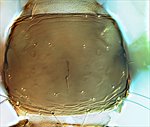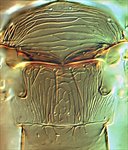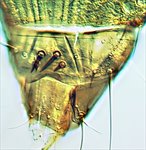
firmus antenna

firmus pronotum

firmus meso & metanota

firmus tergites VI-X

firmus male sternites IV-V

firmus male tergite IX
Generic diagnosis
Female macropterous or micropterous. Head wider than long, mouth cone long; maxillary palps 3-segmented; eyes with five weakly pigmented facets; ocellar setae I present; setae III arising on posterior tangent to posterior ocelli; five pairs of postocular setae. Antennae 8-segmented, segment I without paired dorso-apical setae, III and IV with long forked sense-cones, III–VI with some rows of microtrichia on both surfaces, IV–VI pedicilate. Pronotum with no sculpture medially, two pairs of long posteroangular setae; anteromarginal setal pair longer than discal setae; three pairs of posteromarginal setae. Mesonotum with median pair of setae near posterior margin; anterior campaniform sensilla present. Metanotum reticulate medially; median pair of setae at anterior margin; campaniform sensilla present. Fore wing first and second veins with setal rows complete, but setae not closely spaced; posteromarginal fringe cilia wavy; clavus with five veinal and one discal setae. Prosternal ferna not divided; basantra membranous, without setae; prospinasternum broad and transverse. Mesosternum with sternopleural sutures complete; endofurca with spinula. Metasternal endofurca without spinula. Tarsi 2-segmented; fore tarsi each with stout pretarsal tooth. Tergites IV–VII with S2 setae minute, much shorter than S1 setae; VIII with weak, irregular and indistinct ctenidia anterolateral to each spiracle; VIII posterior margin without comb but with weak and indistinct translucent teeth; X with longitudinal median split almost complete. Sternites without discal setae, posterior margins with small craspeda lobed between marginal setae; sternites III–VII with three pairs of posteromarginal setae, II with two pairs; laterotergites without discal setae.
Male macropterous; tergite IX with two pairs of short stout setae medially; sternites III–VII each with a large transverse pore plate.
Biological data
Little is known of the biology of this species but it is possibly associated with Vicia cracca [Fabaceae], according to zur Strassen (2003).
Distribution data
Widespread in northern and eastern Europe (zur Strassen, 2003), two females of this species have been recorded from eastern China, Nanjing (Mirab-balou et al., 2014).
Nomenclatural data
Taeniothrips (Firmothrips) Schliephake, 1972: 274. Type species Oxythrips firmus Uzel 1895, by subsequent designation of Bhatti, 1978: 189.
Only one species is placed in this genus (ThripsWiki, 2020), and this eastern European species has been recorded from China:
firmus (Uzel, 1895: 138). (Oxythrips)
Relationship data
Thripidae sub-family Thripinae: this is a diverse group involving more than 230 genera. This is one of nine genera recognised as the Frankliniella genus-group (Mound, 2002), within which Wang et al. (2019) indicate a relationship to Parabaliothrips. Firmothrips shares with the European genus Sitothrips the very weakly developed tergal ctenidia, and presence of a pretarsal tooth on the fore tarsus. The ctenidia are represented by a row of a few microtrichia on tergite VIII and sometimes also on VII.
References
Mirab-balou M, Yang SL & Tong XL (2014) The Frankliniella genus-group (Thysanoptera: Thripidae) in China, with a newly-recorded genus. Entomotaxonomia, 36 (2): 97–104.
Mound LA (2002) The Thrips and Frankliniella genus groups: the phylogenetic significance of ctenidia. Pp. 379–386 in Marullo R & Mound LA [eds] Thrips and Tospoviruses: Proceedings of the 7th International Symposium on Thysanoptera. Australian National Insect Collection, Canberra.
ThripsWiki (2020) ThripsWiki - providing information on the World's thrips. <http://thrips.info/wiki/Main_Page>
Wang ZH, Mound LA & Tong XL (2019) Phylogenetic relationships within the Frankliniella genus-group based on morphology, with a revision of Iridothrips (Thysanoptera, Thripidae). Zootaxa 4651 (1): 141–154.
zur Strassen R (2003) Die terebranten Thysanopteren Europas und des Mittelmeer-Gebietes. Die Tierwelt Deutschlands 74: 1–271.